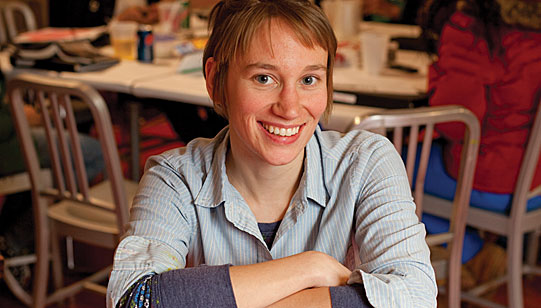 Spring 2010
Spring 2010|
|
What is printmaking? Printmaking is any sort of method of making multiples. It can be silkscreen printmaking, offset lithography. Making newspapers is printmaking. Did you always want to teach? I’ve been in museum education since probably 2000, in some form or another. So, yes. In addition to museum teaching, when I was in Madison (WI) I would tutor Native American students and work with adult women with disabilities. And I taught art history when I was in grad school. Teaching printmaking to teens has been really exciting. This tool of silkscreening has been a great impetus for us to teach a kind of activist art. Is that what RUST is all about? In RUST (Radical Urban Silkscreening Team, a collaboration between The Warhol and Artists Image Resource), we start with a basic technical understanding of silkscreening—how to do it very easily and quickly and with little materials. We want to teach kids that they could be doing this at home. Then it’s about making sure they realize they have a voice, and they can use this tool to express their voice in any way they would like, and here is a way to disseminate information—just getting information out there, getting your voice out there. Can you give an example? In the first RUST program, one of the students, Tyler Shine—who now works at the Museum of Art—had one of his posters used by Fed Up, a local prisoners-rights advocacy group. Tyler designed a pamphlet that was just so beautiful—the imagery was very sad and beautiful and just really hit home. It was on behalf of juvenile lifers in Pennsylvania. Fed Up ended up using it in its efforts to help change the law so that these kids might have the possibility for parole. How did he choose that subject? A woman from Fed Up came in and gave a presentation. We had also watched a couple of Frontline specials, and this was one of the topics. Once something interests a student, we provide them with connections to different organizations. That’s also the way it works with Power Up, this women’s health advocacy program that I’m working on with Mary Tremonte, The Warhol’s coordinator of youth programs. We have six girls from Perry High School and Pittsburgh Urban Pathways participating three afternoons a week, designing a lot of tri-fold pamphlets and posters. We’re working with Planned Parenthood, Youth Empowerment Project, the Birth Circle, the East End Food Co-op, some students from Pitt law school, and we have two presenters every week, and the girls choose which projects they want to be on. You did the same kind of thing last year in Brazil. What was that like? I went to Brazil with Bill Rodgers from AIR in 2008 and then with Mary (Tremonte) in 2009. It was really great. We’re not fluent in Portuguese, so we were very dependent on the other educators there (from the Museum of Contemporary Art in Niteroi, Brazil). They were good for us, and I think we were a good catalyst for them. You were working with kids from a really poor area. Was it difficult to get them to rally around this? I think it’s harder because they have no support. These kids need to go get jobs; they don’t need to be involved in some after-school programs. We run into that with our after-school program in Pittsburgh, too, and those positions are even paid positions. At the same time, the kids that we worked with in Brazil were so energetic. And there was no shyness. They just do it; they get in there and get their hands dirty. And they are so excited to work. You show a few of them once and they show each other how to do it. Do you think most kids, anywhere, are just waiting for someone to tap their creativity? Yeah, I’m always amazed—you know the potential is there, but how can we get at it? Most people rise to the occasion. And I feel like we don’t do that enough with teens. They’re just waiting for opportunities to show what they can do. Do you ever get frustrated you can’t reach more kids with these programs? Sometimes. But I feel like, especially at The Warhol, we’ve done so many projects like this where it’s a really focused long-term project with a core group of kids and I feel like we get to make such an impact. And those kids actually then make a huge impact on their peers, and it’s great. And it’s not all about art. The girls we’re working with in the Power Up program—none of them will be art majors. That’s really great because it’s even more special. They might have had art a half hour once a week, if they had it at all. So this program really can be their creative outlet, and they love it. |
Also in this issue:
I Just Want to Watch · The Next 15 · Regenerative Medicine: A Growing Future · Run, bounce, spin, climb— and learn! · President's Note · NewsWorthy · Science & Nature: Our Super-sized World · Artistic License · About Town: Asking Andy · The Big Picture
 |
Copyright © 2017 CARNEGIE Magazine. All rights reserved. |

